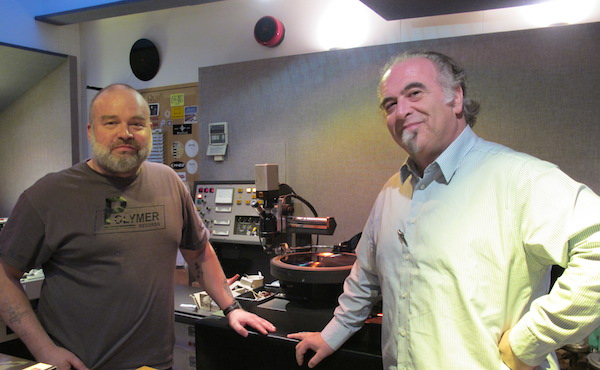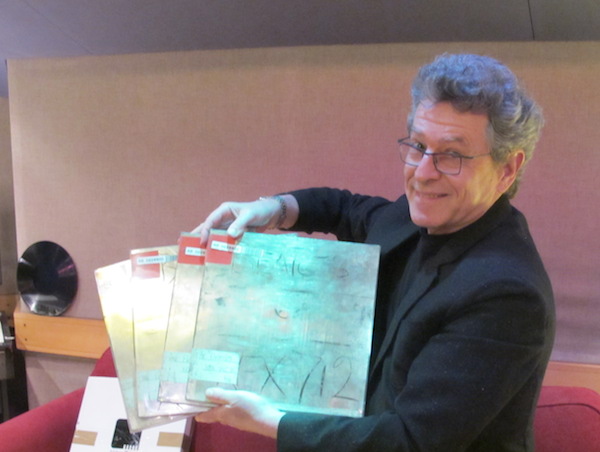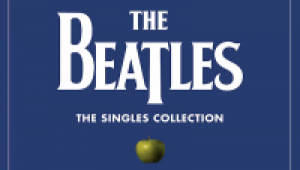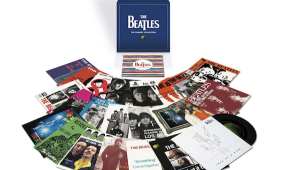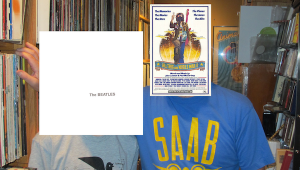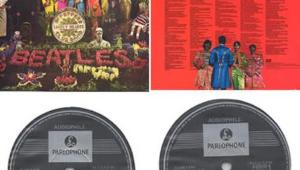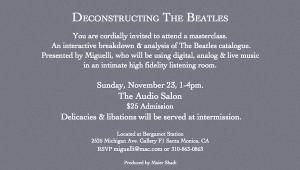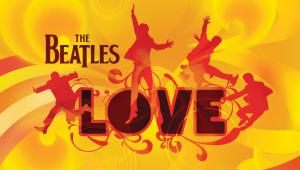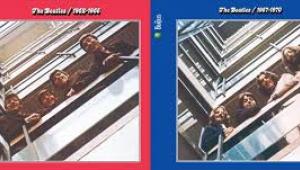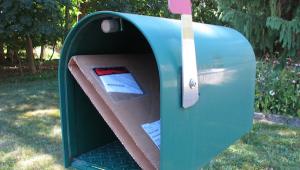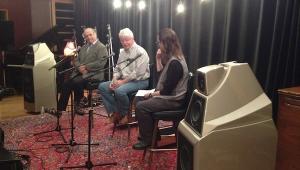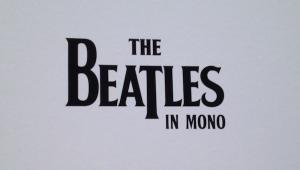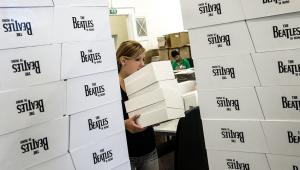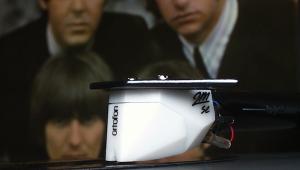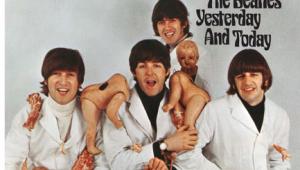It will probably be around for a awhile (at least the individual LPs). HOWEVER, if you really want them, I would buy earlier than later. Just look at great vinyl issues from the past ten years. Most sell out and then if you want it later, you pay big bucks.
The Beatles Get Back To Mono and AAA Vinyl
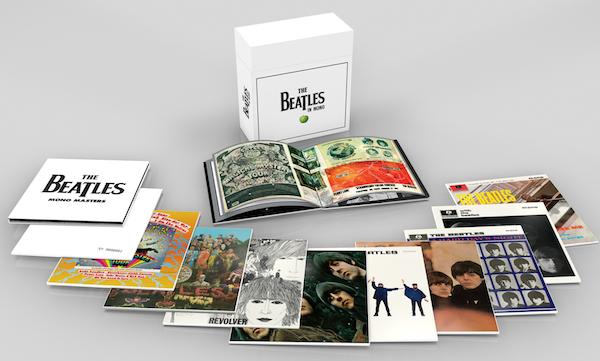
Apple Corps and Universal Music Group today announced the September 8th release date (September 9th in North America) of the long-anticipated Beatles’ mono vinyl reissue series, cut to lacquer using the original analogue master tapes.
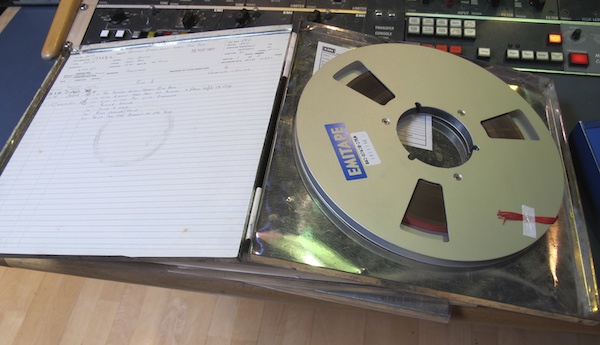
The release includes all nine original mono mixed U.K. albums plus the original American-compiled mono Magical Mystery Tour and the Mono Masters, a 3 LP collection of non-album tracks also compiled and mastered from the original analogue tapes.
Each album will be available individually and within The Beatles in Mono, a lavish, limited edition 14 LP boxed set that includes a newly produced 108 page hardbound book.
The albums are presented “…in their original glory, both sonically and in their packaging” the press release asserts, so that could mean fold-over type, Clairfoil-like laminated jackets and greater attention to original packaging detail compared to the stereo box.
The 180 gram records, pressed at Optimal in Germany for world-wide distribution, were mastered at Abbey Road Studios using the original ¼” analogue master tapes played back on a mono headstock, preview-head equipped, Studer A80. No dynamic compression and minimal equalization will hopefully produce the best ever sounding Beatles reissues.
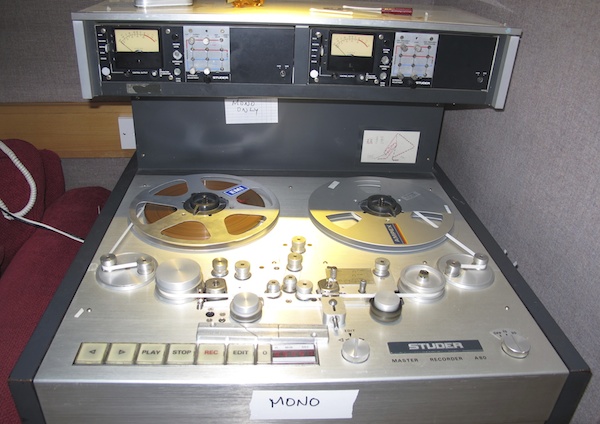
The EQ applied was based upon the original cutting engineers’ notes as well as careful listening to original first lacquer, first mother, first stamper EMI pressings (-1, 1, G matrix). The cartridge used was Ortofon’s 2M Black.
It’s important to remember that the tapes have aged—some as much as fifty years—and the monitoring, playback and mastering equipment have changed as well, even though the work was done in the very same room in which the originals were mastered. Solid state has replaced tubes in the cutting chain.
Lacquers were cut using Abbey Road Studios’ Neumann VMS-80 lathe, equipped with a Neumann SX-74 cutter head. The originals were cut on a Scully lathe, perhaps with a Westrex cutter head.
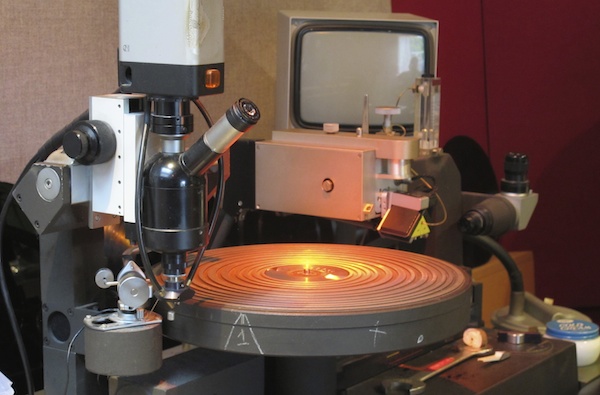
The extensive listening and final post production work was accomplished by Abbey Road’s GRAMMY® Award winning engineer Sean Magee and GRAMMY® Award winning mastering supervisor Steve Berkowitz, well-known for his Bob Dylan and Miles Davis catalog restoration work, among others, as well as for his production of Dylan’s long-running and highly acclaimed Bootleg series.
I was privileged to attend a May 14th, 2013 Abbey Road Studios mastering session during which lacquers were cut for all four sides of The Beatles (the “White” album). So yes, I got to hear and hold in my hands actual Beatles master tapes.
It was a truly magical experience as was getting to walk into famed Studio Two where all of the magic occurred. I was initially told it was off limits because it had been booked for a session but the band was late so in I went. It was a never to be forgotten “day in the life”.
I’ve had to keep the visit out of print for more than a year as the mono LP release date was pushed back more than a few times so Apple and UMG could be sure everything was done correctly.
Readers of my Stereophile “Analog Corner” column might recall last year’s coverage of 2013’s Munich Hi-End show as well as a visit to the Record Industry pressing plant in Holland. The column included this line: “I’ll spare you the details of my boring Tuesday (there was a fantastic Bowie museum exhibit in town but it was sold out and my ballsy emails to Tony Visconti, who I’d barely met at the Classic Album Sundays event, looking for a ticket ‘in’ had gone unanswered)”.
That “boring Tuesday” was the day I spent at Abbey Road. It was a very inside joke!
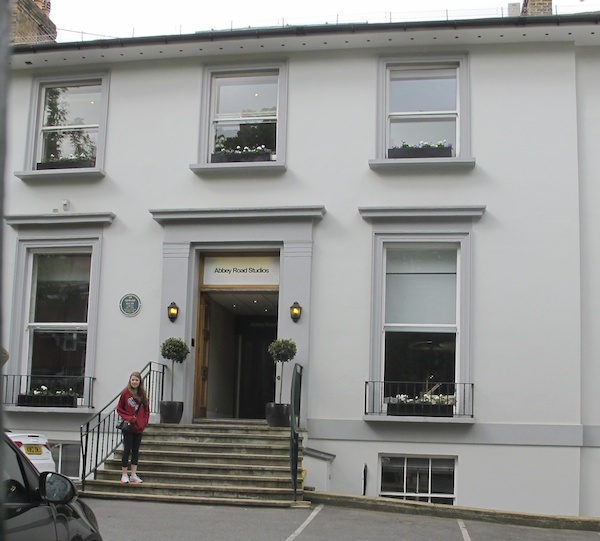
Berkowitz had been hired to oversee the mono vinyl reissue set by Jeff Jones his former boss at Sony/Legacy and current Apple Corps CEO.
Early in 2013 I received calls from an EMI representative and from Berkowitz inviting me to visit Abbey Road to witness the production of the long-promised mono vinyl reissue series.
Steve Berkowitz and I go back more than forty years to my first day of Boston University Law school in the fall of 1969. I took a lunch break walk into Kenmore Square and discovered the New England Music City record store. I didn’t have time to browse, I thought, but then I spied at the top of the corner store’s stairs a cardboard point of purchase display filled with an imported album. Those were obvious because the Europeans didn’t use warp inducing shrink wrap. Instead, they used a loose fitting sealed plastic recognizable to any import junkie.
I had to see what it was so I walked up the steps and it was The Beatles new Abbey Road album not due out in America for two weeks! Of course I bought a copy but should have bought two or five. That copy is still the best sounding Abbey Road I’ve ever heard.
What does Berkowitz have to do with that story? He was the record buyer at New England Music City and was responsible for ordering those albums. By the way, he too can’t believe he didn’t buy a few extra copies and he too says the copy he bought from that shipment is the best sounding Abbey Road he’s ever heard.
So first he’s responsible for me having the best sounding Abbey Road and now, forty 45 years later, he was inviting me to Abbey Road!
The EMI representative told me that after absorbing the criticism heaped on the digitally sourced stereo box—including the extensive analogplanet.com coverage, which was correctly construed as constructive criticism—the decision was made to produce the mono LPs using an all analog mastering chain.
Berkowitz told me that in his opinion and in the opinions of many, the mono mixes were the more important reissues and I agree. They were the ones The Beatles listened to and to which they paid more attention during mixing. The monos were the ones most kids back then heard both on the radio and at home.
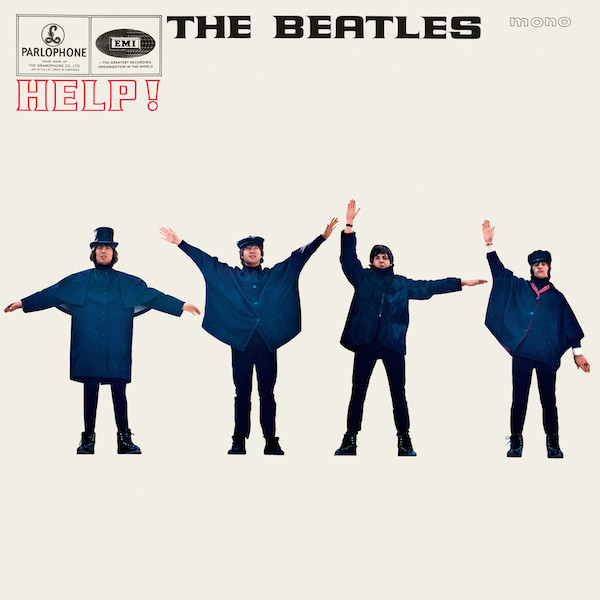
And in reality the albums were produced for mono. The first two albums recorded to BTR two track machines featured voices on one channel and instruments on the other to allow easy post-production leveling. Abbey Road added four track machines as early as 1963 with “I Want to Hold Your Hand” being the first song The Beatles recorded using four tracks.
Still, four tracks hardly sufficed for their increasingly complex arrangements. As the tape's four tracks filled up and were mixed down to one to make room for more music, these pre-mixes were produced with mono in mind so that when all of the tracks were folded together, they would fit together like a stack of cards. That's why the mono set sounds so coherent and why arguably you can actually hear more detail in mono.
The mixers created "stereo" by separating (as best as they could) what was intended to be blended, and panning the elements across the soundstage. Since it had previously been pre-mixed, what could be done to separate the pre-mixed elements was limited.
When I interviewed Ken Scott, he told me that Paul wanted the stereo mix of The Beatles to be as different as possible from the mono because that might induce fans to buy both. The mono mix came first. And the two mixes are very different. You could say the stereo mix was more about commerce than art. If you grew up listening to the stereo mix, the mono will be an ear opener.
Of course at the time stereo was relatively new and novel so listeners craved hearing "separation" across the soundstage, but today we're all more sophisticated listeners. Hearing the records as originally intended, to me, is the best way to listen.
The day, Tuesday, May 14th began with a rainy morning car ride to Abbey Road. I’d done the tourist walk back in 1982 when I was in London to attend the “TRON” soundtrack recording sessions at The Royal Albert Hall, but this time I was going in!
Still, I did the walk across the street in the rain first, almost getting run over in the process.
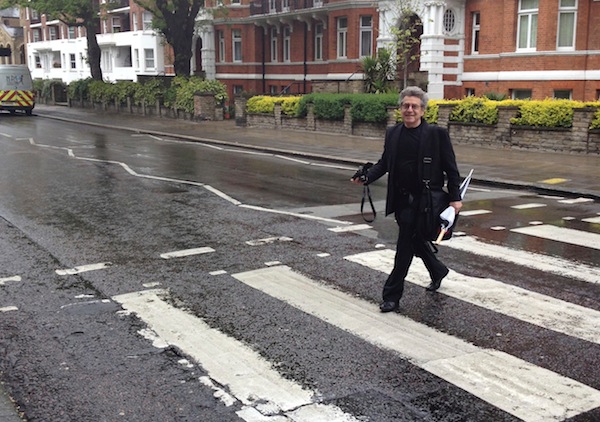
- Log in or register to post comments


both Mono and stereo CDs and the stereo LPs still available? And at a cheaper price? I know the mono CD box sold out quickly the first go around but the second issue is still around.

the CD box sets won't be of much value and the stereo LP box set was a disaster so it obviously won't be valuable. But if these are done as well as I think they will be they may sell out relatively fast and become pretty valuable

This fantastic news to say the least. Now to set up for Mono (though I have been enjoying my current mono releases as is). Question is where does the Y adapter go? I don't have a mono switch on my Marantz AV550 preamp. In addition, I use a Carver AV806 amp and Jasmine phono pre for my VPI Traveler w/Grado Gold. The Jasmine does have inputs for 2 turntables but that would be a route I can't go for right now.
I can order the Y adapter from Blue Jeans in time for the box set!!! Just need to know how to hook it up.

Hi Folks: I know this is an ODD question, but: does anybody out there have the Book from the Stereo Vinyl box set that they would be willing to sell for a reasonable / fair price? I got "stiffed" so to speak on a 'used' copy of the set (no wonder it was so cheap!). Thanks.
( I Hope it's okay to say that you can contact me at: dailyville@sonic.net

My apologies, but I went back through and couldn't find the answer to this. In what direction does the "Y" adapter get connected? Are you combining the left and right channels from the pre-amp into one channel feeding the amp, thereby listing to only one speaker? Or are you taking only one channel from the pre-amp and feeding it to both channels of the amp? I have a Benz LPs on a Graham Phantom II Supreme and I'm loathe, (hey I used that word in a sentence!)to spend more money on a mono cartridge for one set of mono records.

What I remember from the stereo LP remasters is controversy and assertions from EMI that Apple or the surviving Beatles (and families) would only approve what was done (i.e. using the 2008/9 digital files).
Nice to see that a bit of constructive criticism spearheaded online reveals that not only are masters previously thought to be infinitely precious/unavailable/unusable actually available, but that they'd spend a buck or two going through the entire analog process to give us what we what.
Bravo!

A great and unique story. I'm not sure if I will get the whole box (probably will though), because I have all the UK originals, but I'm sure to add the mono masters album.
One question. Since they're mono presses, should I play them with my Lyra Helikon Mono or With my Shelter 901 MKIII (stereo)?
I read somewhere that records cut after about 1968 are cut with a stereo stylus, regardless of whether they're stereo or mono.

The SX74, being a stereo cutter head, does have two coils but we'd imagine only the lateral cut is being done since the records are mono.
The groove depth probably won't necessarily be the same as a vintage record's but I doubt your line-contact stylus will care about that.

Leader tape in between tracks is a clear indicator of original album master tapes. Doesn't look like these masters have leader tape separating each track, so could this mean they used safety copies to cut the new LP's?


Personally I liked but was never knocked out by any Beatles mono, save for Pepper and a few other mixes. However with due respect to all of my mono/vinyl friends, I do hope this mono set meets their expectations. Got my fingers crossed!!

The box I would purchase would be Please Please Me through Rubber
Soul in MONO -Revolver -Sgt. Pepper-Magical Mystery Tour-The
White Album-Let It Be-Abbey Road- in Stereo!
All from the original analog mix down masters. Pressed at one of
the known best pressing plants somewhere in Germany.(180-200gm)
That would really be something!!!!!!!!!!!!!!

Regarding the questions about whether a mono cartridge is required or advisable for these reissues, there was a very interesting feature in this month's edition of Uk magazine HiFi World.
Editor Noel Keywood has apparently been the instigator for Ortofons new 'Special Edition' 2M Mono cartridge.
The new cartridge differs from the previous 'standard' 2M mono cartridge in having a 6um Shibata stylus instead of a 18um spherical stylus.
Apparently OLD i.e. original, 'back in the day', mono pressings had bigger grooves for which the larger 18um styli are optimal. The new Beatles mono pressings (and presumably other 'modern' mono repressings) are optimized for (mono) replay using standard modern stereo cartridges which have smaller styli. So the new Beatles mono pressings will have smaller grooves.
In Keywood's opinion playing the new mono pressings with a mono cartridge fitted with 18um spherical stylus will be highly sub-optimal (resulting in severe reduction in hi frequency response) and highly likely to result in actual DAMAGE to the records.
Hence the new 2M mono SE with Shibata stylus.
Playing with standard stereo cartridge will be absolutely fine and is actually advisable to using a cart optimized for OLD mono records.
AFAIK the only downside to using a standard stereo cart over say the new Ortofon would be possible increased surface noise, but as these are new (hi-standard) pressings that should not be a big issue.
(I hope readers can excuse my lack of technical precision here! I'm recalling from memory, but the gist of this is perfectly correct. I advise readers to source a copy of the magazine if they want to know more)

Can this new set achieve the Wow factor? What I mean, is it possible for this set to deliver substantial higher fidelity over what we've heard before or will we just notice minor or subtle improvements? To be honest, when the Beatles first came out (yea, I was there eating it all up as it happened in College Point N.Y.)I would have been happy listening to them on an Edison Cylinder (even though I'm was born a stereo guy). Were the guys over at Abbey Road really able to squeeze more out of those 50 year old tapes? Fingers crossed....

Oh, bye the way..since these new mono lp covers are supposed to be exact replicas of the originals, outside of the bar code on single releases, how do we differentiate between them and original first pressings.

Yes, duplicating the non-linearity of the contemporary typesetting processes, which characterise the text elements of the labels of the original pressings would never have been considered practical.
The UK '81 Mono vinyl reissues included the text 'MONO' above the (approx.) 'PHONE' of the yellow PARLOPHONE text, and placed where 'STEREO' appeared on the STEREO Apple labels. Is this also a 'feature' of the new labels?

Up until a Beatles fanatic fellow-musician friend of mine said the other day how amazing the Beatles albums in mono were, I wouldn't have been SLIGHTLY interested - though I was bemused at how much more expensive the mono box set actually is...
I've just started collecting LPs after a 30-or-so-year hiatus and am starting to rebuild my collection. So far I've got about 80, comprising good second hand original pressings of some of my favourite albums, and a good many brand new reissues, bought (for the most part) because of recommendations and reviews I've read on other forums.
Most ridiculous thing about this is that I'm yet to buy a turntable....
I'm LOVING this forum though, having just stumbled upon it a few hours ago. The discourse is mostly intelligent, good-natured and fascinating for someone rediscovering the joys of vinyl after so many years. I especially appreciate Mike's clearly authoritative yet open-minded comments regarding the topics.
Given that the Beatles must comprise part of any comprehensive collection, I've already invested in the latest pressings of both Abbey Road and the White Album, as the consensus seems to be pretty positive re- the latest vinyl reissues in both cases, save a few dissenting opinions. I was VERY interested in the latest stereo vinyl box until I read the comments here...
Aaaaanyway... my question now is whether it would make more sense for me to continue accumulating the stereo Beatles records I want on a piecemeal basis, whilst forking out for the mono set...
Thoughts?
Anyway

I really don't think this project is going to be "pure analog" as they say. They're most likely going to use digital delay lines for monitoring, equalizing, and level adjustment when they do the cutting which basically makes it digital at that point. I highly doubt they're going to do it the old fashioned way by mounting a preview head on the mastering deck. It's just way too expensive and much much more difficult and prone to costly mistakes.
I won't believe it until I get a confirmation from an actual representative for the project.

Pure analog in today's world? By that definition, Abbey Road would have to use gas generators for the electricity. For me, if these new L.P.'s blow away all previous mono releases, it won't mean a hill of beans what, and how much of what format works it's way into the chain!

Dear Mike,
It seems like the parties have gone to great lengths to create a record that is true to the original mono releases of these records. If that is so, why not just use the stampers from those original releases?

Do you know if they will be releasing the mono LP's individually just as they did with the 2009 Stereo re-masters?

Thats ok as I have top loaders of both the stereo and mono White album. It will be interesting to find out how these 2014 lp's compare with the 1982 Japanese EAS mono red vinyl

Wow, what an experience that must have been at Abbey Road.
Thanks for sharing it with everyone. I also commend you for being able to keep it quiet for a year!
I was curious if you might know...
- Is the white album numbered? or the box set itself numbered?
- what do the record labels look like? Old school Parlophone for PPM? What about MMT? Capitol colorband?
Thanks so much!
- Dave

Oops - saw you just answered the numbered Beatles White Album. Thanks for that answer!

Will be interesting to see what the 'early numbers' will go for when they ultimately make their way onto online auction sites.

I've put hesitation behind me and ordered the boxset. Despite hailing from Australia, it's still approx $100 cheaper (shipping inclusive) to import the set from the U.S. rather than purchase locally. Odds-bodkins perhaps but for such a saving, I'm happy to wait the extra week for delivery.
I have greatly enjoyed reading the article and all the comments of all respondents. And although I got a bit lost in the hyper-technobabble, it has been a very entertaining late afternoon.
Thank-you to all.

If I could have Beatles in stereo, I would definitely prefer it. But the fact is that we only have the Beatles in mono. The so-called stereo mixes have nothing to do with stereo. They are mono, distributed between left and right. To talk of stereo, you must have two seperately recorded channels of each and every sound. When Beatles recorded, there was one channel only for each voice and each instrument. The 'stereo' mixes of Beatles produce an artificial sound, a poor, chopped-up mono sound, which I have always found annoying, simply removing the experience of a band playing in one room.

Hi Mike, Can you help me with making sure I can get the best experience from the Beatles MONO VINYL? I have a Technics 1700MKII - Grado's stereo cartridges - B&K Amp ST3030 and Pre-amp PRO10 (MONO SIWTHC) and Carver AL III Speakers. With that said, I would like to get the best sound when listening to these Beatles Mono Vinyl. Would a mono Cartridge make a difference? Do I need to get the OROFON special Cartridge or would a Grado be sufficient. I have the MOBILE FIDELITY Vinyl I bought new in '78 and always thought they were the best sounding. I have the Mobile Fidelity UHQ Vinyl Sgt Pepper too. Your recommendation would be most appreciated! And I envy you at ABBEY ROAD! Awesome! Thanks Art

I too need advice, please!
Apart of my regular stereo analog system, I'm putting together a mono vinyl replay system for this remasters. The turntable is an old modified Thorens (unidentified model) with Rega RB300 arm. I will be using an Audiolab 8000A as phono preamp plugged into my Audio Research Reference 3 through its pre outputs.
The only thing I need to buy now is the cartridge, and the choice doubt is between this Ortofon 2M Special Edition or the cheaper Ortofon OM D 25 MONO. I have a lot more mono records (Jazz mainly), but is this remaster that I want to enjoy fully.
Any advice???
Thanks a lot!
Peter
